|
VP9GE Ed Kelly |
|
|

|
||
Data
policy 
|
||
| 1 Tarrafal
Drive, Hamilton CR 04, Bermuda - Voice:
441-293-2525 | Maidenhead locator: FM72pi Location: 32.350N, 64.720W |
||
|
VP9GE Ed Kelly |
|
|

|
||
Data
policy 
|
||
| 1 Tarrafal
Drive, Hamilton CR 04, Bermuda - Voice:
441-293-2525 | Maidenhead locator: FM72pi Location: 32.350N, 64.720W |
||
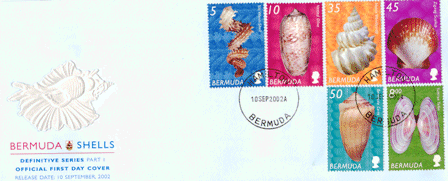
The Islands of Bermuda
rise from the Atlantic nearly 700 miles from the East Coast of the United
States. The 21 square mile land mass
enjoys a sub-tropical climate and is home to the northernmost coral colonies in
the world.
Bermuda, the oldest and most populous of the
remaining British Overseas Territories, with its reefs and beaches washed by the Atlantic
Gulf Stream, is the habitat of thousands of marine invertebrates. This stamp
series concentrates on the Class Gastropoda (Snails) and a clam of the Class
Bivalvia that are native to Bermuda.
Dr. Wolfgang Sterrer
reports in Marine Fauna and
Flora of Bermuda, “all three subclasses of Gastropoda are represented in
Bermuda waters. Of 39,000 marine gastropod species, approximately 375 have been
reported (and another 50 collected but not positively identified) from
Bermuda”.
Bermuda Conchologist
‘Jack’ Lightbourn collected the specimens photographed for the stamps between
1936 and 1986.
Please consult the
Endangered Animals and Plants Act 1976 before collecting, exporting or
importing seashells.
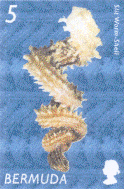
5c – Slit Worm Shell Siliquaria squamata Blainville, 1827, 67 mm
Family: Siliquariidae
These long, slender
coiling shells grow in clumps or attach themselves singly to shells or rocks.
The specimen on the stamp was dredged from 92 meters of water off the South
Shore in 1973.
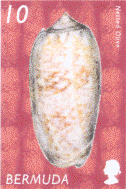
10c – Netted Olive Oliva circinata Marratt, 56 mm
Family: Olividae
Shells in this family
are known as ‘olives’ because of their usual cylindrical, squat shape. The shells are thick and quite glossy due to
the animal living in sand. Olives are
carnivorous and feed mostly at night. They are found on sand flats in depths to
30 metres.
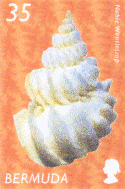
35c – Noble Wentletrap Sthenorytis
pernobilis (Fischer
& Bernardi, 1857), 46 mm
Family: Epitoniidae
This beautiful, rare
shell is found in depths of 100 to 1,600 metres of water. Wentletraps are
popular with collectors because of their intricate ribbing. Epitoniidae belong
to the same order (Heterogastropoda) as Janthinidae (on 80c stamp to be issued
in Part II). This particular specimen was found at a depth of 350 metres off
Castle Roads in 1979.
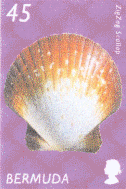
45c – Zigzag Scallop Pecten ziczac (L., 1758), 48 mm
Family: Pectinidae
The Zigzag is one of a
large family that is popular both as food and as a collector’s item. Some
species are capable of swimming by snapping their valves. The design differs on
opposite valves. Scallops can be found in both warm and cold waters. The
specimen shown was found in 1982 on a sandy, grassy bottom in three metres of
water.
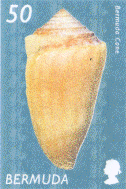
50c – Bermuda Cone Conus mindanus Hwass, 1792, 57
mm
Family: Conidae
Over 600 cone species
are known but there is some duplication due to variations in colour, patterns
and sizes. Cones live in sand and gravel under 3 to 9 metres of water. This
cone was originally named Conus bermudensis Clench, 1942, and thought to
be unique to Bermuda. The poison of some cones may be lethal to humans. The
eggs of the cone are deposited in small purse-shaped capsules.
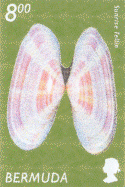
$8 – Sunrise Tellin Tellina radiata L., 1758, 80 mm
Family: Tellinidae
This family of colourful
shells consists of thin, oval clams and are found in most parts of the world.
The species found in the shallow waters of Bermuda are quite colourful. Tellin
live under 15 to 45 cm of clean sand and, while quite tasty, are not commonly
used for food. The specimen was found off the West End in 1974.
First Day Cover – Lightbourn’s Murex Pterynotus lightbourni
Harasewych & Jensen, 1979, 38 mm. This rare, delicate Bermuda seashell was crabbed in
1977 in 400 metres of water south east of Gurnet Rock. During the next fourteen
years only ten more specimens were found. Of these only three were of gem
quality.
Acknowledgements to Mr. ‘Jack’ Lightbourn who
provided the shell specimens. Also to Mr Lightbourn and K. Ed Kelly for liner
information.
TECHNICAL DETAILS
Designer………………………………………………………………………………..Sheila
Semos
Digital
Photography…………………………………………………………………….K.
Ed Kelly
Stamp Size &
Perforation…………………….28.42 mm x 42.50 mm with 14 perforations per 2 cms
Values………………………………………………………………..……5c,
10c, 35c, 45c, 50c, $8
Release
Date…………………………………………………………………………..20th June 2002